Legal and Professional Accountability in Nursing: Case Study Analysis
VerifiedAdded on 2020/04/07
|8
|2165
|47
Case Study
AI Summary
This case study examines a nursing scenario involving legal and professional issues, focusing on a nurse's actions and their consequences. The case highlights the importance of frequent patient check-ups, proper documentation, timely communication with doctors, and adherence to professional standards. The nurse's failure to meet these responsibilities led to a breach of standards, including those related to plan development, assessment conduction, and critical thinking. The study emphasizes the significance of professional behaviors such as regular observations, patient engagement, and thorough documentation. The nurse's actions were analyzed, and the lessons learned underscore the critical need for nurses to be well-prepared, accountable, and committed to providing effective patient care, ultimately preventing negative outcomes. The analysis also points to the importance of nurses following the guidelines set by their organizations. The case concludes by reiterating the need for nurses to implement their skills effectively and efficiently to ensure patient safety and well-being.
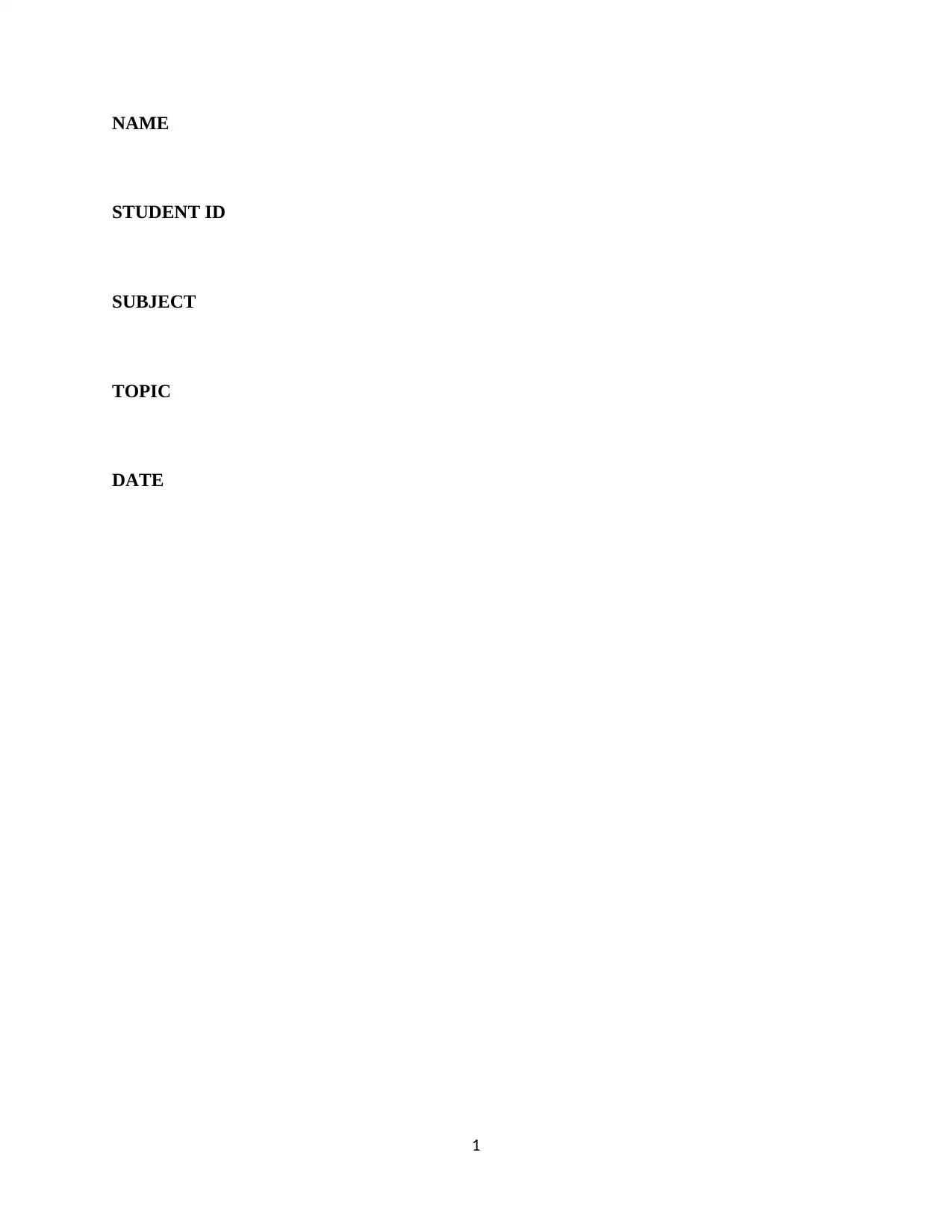
NAME
STUDENT ID
SUBJECT
TOPIC
DATE
1
STUDENT ID
SUBJECT
TOPIC
DATE
1
Paraphrase This Document
Need a fresh take? Get an instant paraphrase of this document with our AI Paraphraser
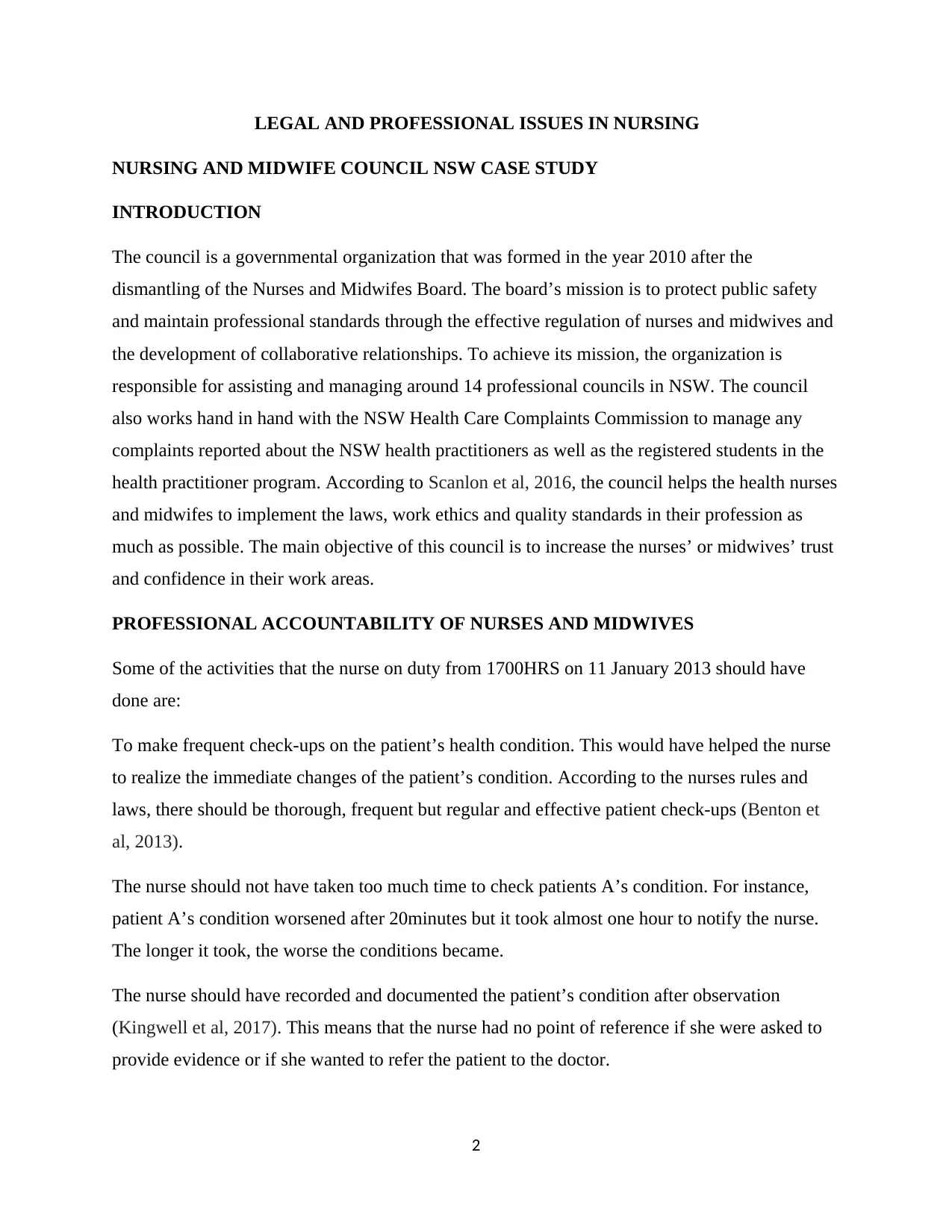
LEGAL AND PROFESSIONAL ISSUES IN NURSING
NURSING AND MIDWIFE COUNCIL NSW CASE STUDY
INTRODUCTION
The council is a governmental organization that was formed in the year 2010 after the
dismantling of the Nurses and Midwifes Board. The board’s mission is to protect public safety
and maintain professional standards through the effective regulation of nurses and midwives and
the development of collaborative relationships. To achieve its mission, the organization is
responsible for assisting and managing around 14 professional councils in NSW. The council
also works hand in hand with the NSW Health Care Complaints Commission to manage any
complaints reported about the NSW health practitioners as well as the registered students in the
health practitioner program. According to Scanlon et al, 2016, the council helps the health nurses
and midwifes to implement the laws, work ethics and quality standards in their profession as
much as possible. The main objective of this council is to increase the nurses’ or midwives’ trust
and confidence in their work areas.
PROFESSIONAL ACCOUNTABILITY OF NURSES AND MIDWIVES
Some of the activities that the nurse on duty from 1700HRS on 11 January 2013 should have
done are:
To make frequent check-ups on the patient’s health condition. This would have helped the nurse
to realize the immediate changes of the patient’s condition. According to the nurses rules and
laws, there should be thorough, frequent but regular and effective patient check-ups (Benton et
al, 2013).
The nurse should not have taken too much time to check patients A’s condition. For instance,
patient A’s condition worsened after 20minutes but it took almost one hour to notify the nurse.
The longer it took, the worse the conditions became.
The nurse should have recorded and documented the patient’s condition after observation
(Kingwell et al, 2017). This means that the nurse had no point of reference if she were asked to
provide evidence or if she wanted to refer the patient to the doctor.
2
NURSING AND MIDWIFE COUNCIL NSW CASE STUDY
INTRODUCTION
The council is a governmental organization that was formed in the year 2010 after the
dismantling of the Nurses and Midwifes Board. The board’s mission is to protect public safety
and maintain professional standards through the effective regulation of nurses and midwives and
the development of collaborative relationships. To achieve its mission, the organization is
responsible for assisting and managing around 14 professional councils in NSW. The council
also works hand in hand with the NSW Health Care Complaints Commission to manage any
complaints reported about the NSW health practitioners as well as the registered students in the
health practitioner program. According to Scanlon et al, 2016, the council helps the health nurses
and midwifes to implement the laws, work ethics and quality standards in their profession as
much as possible. The main objective of this council is to increase the nurses’ or midwives’ trust
and confidence in their work areas.
PROFESSIONAL ACCOUNTABILITY OF NURSES AND MIDWIVES
Some of the activities that the nurse on duty from 1700HRS on 11 January 2013 should have
done are:
To make frequent check-ups on the patient’s health condition. This would have helped the nurse
to realize the immediate changes of the patient’s condition. According to the nurses rules and
laws, there should be thorough, frequent but regular and effective patient check-ups (Benton et
al, 2013).
The nurse should not have taken too much time to check patients A’s condition. For instance,
patient A’s condition worsened after 20minutes but it took almost one hour to notify the nurse.
The longer it took, the worse the conditions became.
The nurse should have recorded and documented the patient’s condition after observation
(Kingwell et al, 2017). This means that the nurse had no point of reference if she were asked to
provide evidence or if she wanted to refer the patient to the doctor.
2
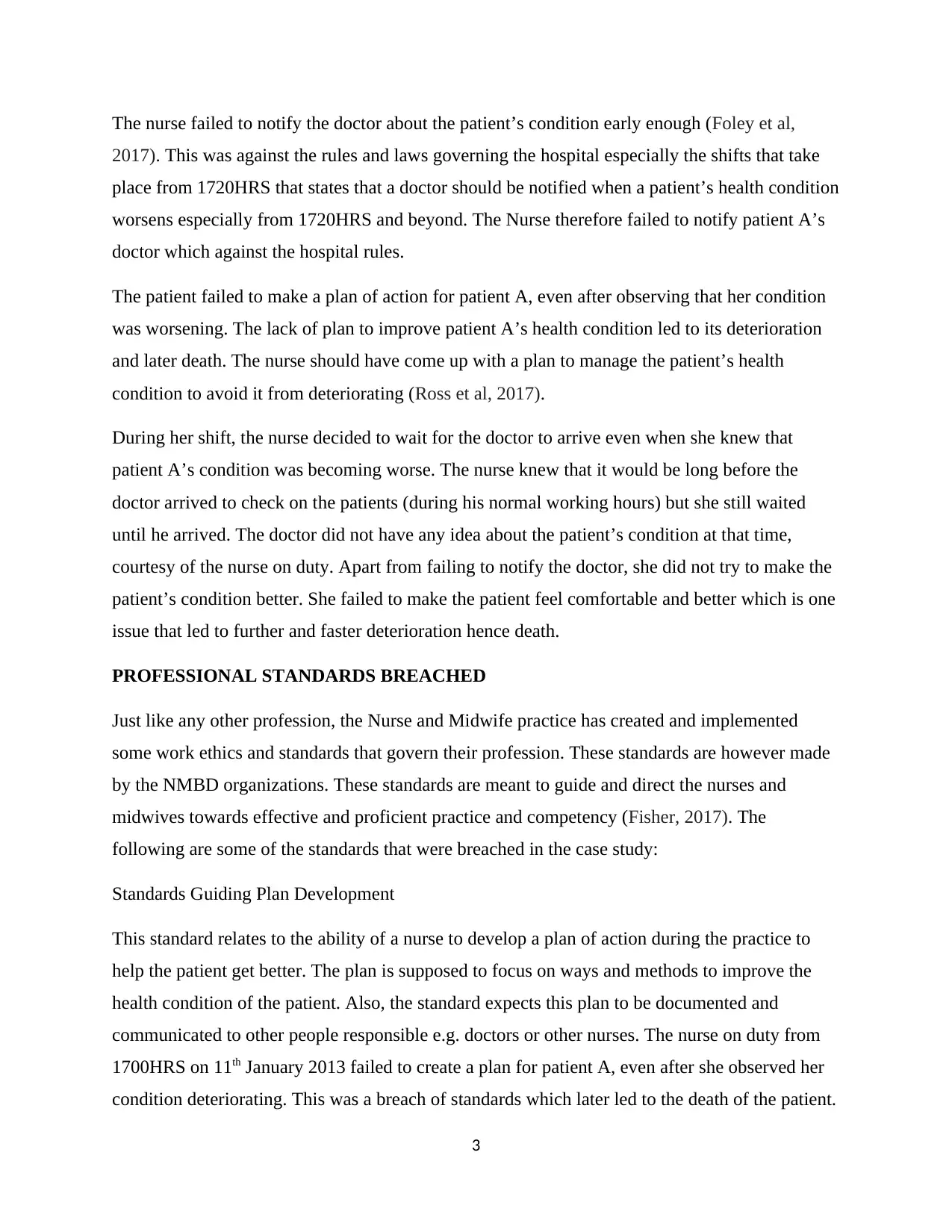
The nurse failed to notify the doctor about the patient’s condition early enough (Foley et al,
2017). This was against the rules and laws governing the hospital especially the shifts that take
place from 1720HRS that states that a doctor should be notified when a patient’s health condition
worsens especially from 1720HRS and beyond. The Nurse therefore failed to notify patient A’s
doctor which against the hospital rules.
The patient failed to make a plan of action for patient A, even after observing that her condition
was worsening. The lack of plan to improve patient A’s health condition led to its deterioration
and later death. The nurse should have come up with a plan to manage the patient’s health
condition to avoid it from deteriorating (Ross et al, 2017).
During her shift, the nurse decided to wait for the doctor to arrive even when she knew that
patient A’s condition was becoming worse. The nurse knew that it would be long before the
doctor arrived to check on the patients (during his normal working hours) but she still waited
until he arrived. The doctor did not have any idea about the patient’s condition at that time,
courtesy of the nurse on duty. Apart from failing to notify the doctor, she did not try to make the
patient’s condition better. She failed to make the patient feel comfortable and better which is one
issue that led to further and faster deterioration hence death.
PROFESSIONAL STANDARDS BREACHED
Just like any other profession, the Nurse and Midwife practice has created and implemented
some work ethics and standards that govern their profession. These standards are however made
by the NMBD organizations. These standards are meant to guide and direct the nurses and
midwives towards effective and proficient practice and competency (Fisher, 2017). The
following are some of the standards that were breached in the case study:
Standards Guiding Plan Development
This standard relates to the ability of a nurse to develop a plan of action during the practice to
help the patient get better. The plan is supposed to focus on ways and methods to improve the
health condition of the patient. Also, the standard expects this plan to be documented and
communicated to other people responsible e.g. doctors or other nurses. The nurse on duty from
1700HRS on 11th January 2013 failed to create a plan for patient A, even after she observed her
condition deteriorating. This was a breach of standards which later led to the death of the patient.
3
2017). This was against the rules and laws governing the hospital especially the shifts that take
place from 1720HRS that states that a doctor should be notified when a patient’s health condition
worsens especially from 1720HRS and beyond. The Nurse therefore failed to notify patient A’s
doctor which against the hospital rules.
The patient failed to make a plan of action for patient A, even after observing that her condition
was worsening. The lack of plan to improve patient A’s health condition led to its deterioration
and later death. The nurse should have come up with a plan to manage the patient’s health
condition to avoid it from deteriorating (Ross et al, 2017).
During her shift, the nurse decided to wait for the doctor to arrive even when she knew that
patient A’s condition was becoming worse. The nurse knew that it would be long before the
doctor arrived to check on the patients (during his normal working hours) but she still waited
until he arrived. The doctor did not have any idea about the patient’s condition at that time,
courtesy of the nurse on duty. Apart from failing to notify the doctor, she did not try to make the
patient’s condition better. She failed to make the patient feel comfortable and better which is one
issue that led to further and faster deterioration hence death.
PROFESSIONAL STANDARDS BREACHED
Just like any other profession, the Nurse and Midwife practice has created and implemented
some work ethics and standards that govern their profession. These standards are however made
by the NMBD organizations. These standards are meant to guide and direct the nurses and
midwives towards effective and proficient practice and competency (Fisher, 2017). The
following are some of the standards that were breached in the case study:
Standards Guiding Plan Development
This standard relates to the ability of a nurse to develop a plan of action during the practice to
help the patient get better. The plan is supposed to focus on ways and methods to improve the
health condition of the patient. Also, the standard expects this plan to be documented and
communicated to other people responsible e.g. doctors or other nurses. The nurse on duty from
1700HRS on 11th January 2013 failed to create a plan for patient A, even after she observed her
condition deteriorating. This was a breach of standards which later led to the death of the patient.
3
⊘ This is a preview!⊘
Do you want full access?
Subscribe today to unlock all pages.

Trusted by 1+ million students worldwide
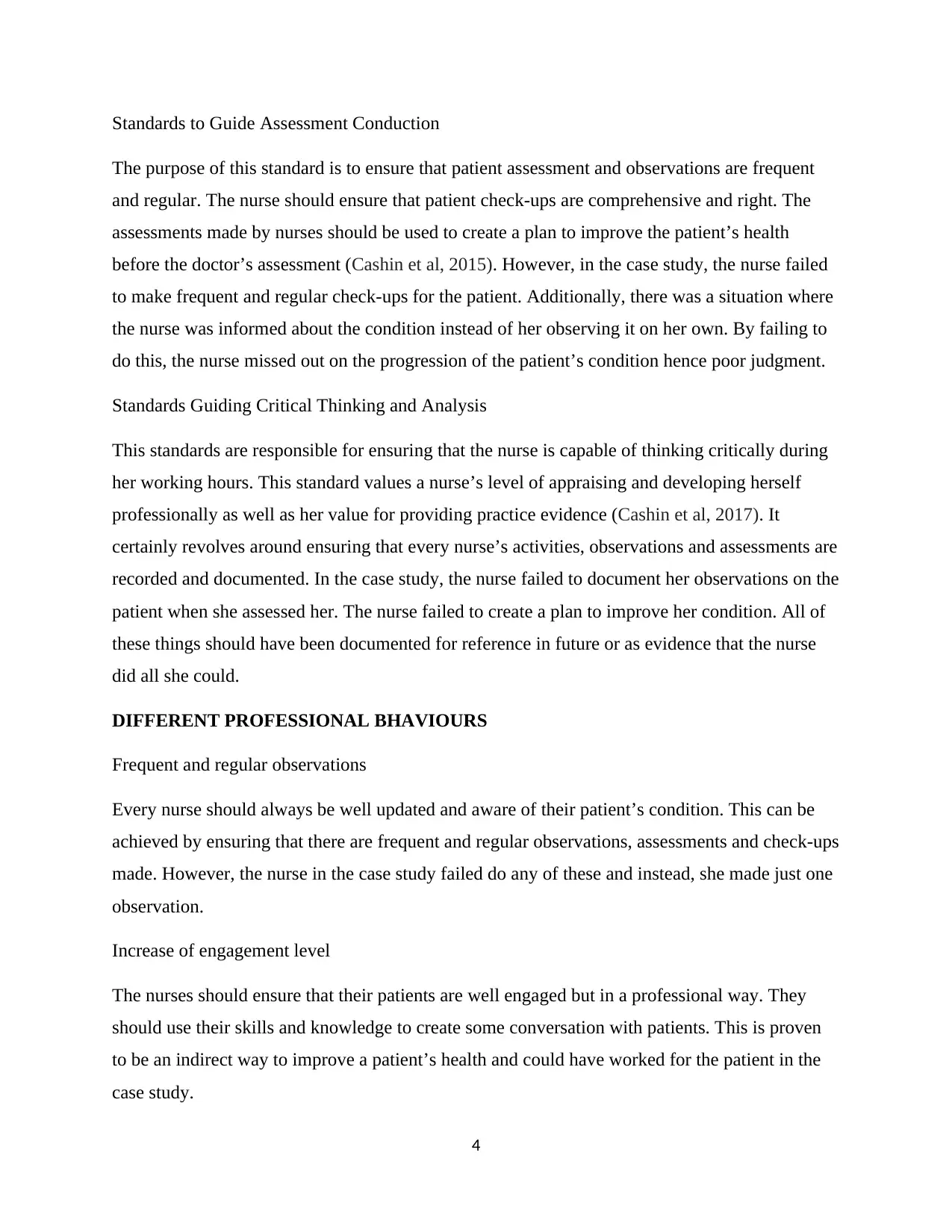
Standards to Guide Assessment Conduction
The purpose of this standard is to ensure that patient assessment and observations are frequent
and regular. The nurse should ensure that patient check-ups are comprehensive and right. The
assessments made by nurses should be used to create a plan to improve the patient’s health
before the doctor’s assessment (Cashin et al, 2015). However, in the case study, the nurse failed
to make frequent and regular check-ups for the patient. Additionally, there was a situation where
the nurse was informed about the condition instead of her observing it on her own. By failing to
do this, the nurse missed out on the progression of the patient’s condition hence poor judgment.
Standards Guiding Critical Thinking and Analysis
This standards are responsible for ensuring that the nurse is capable of thinking critically during
her working hours. This standard values a nurse’s level of appraising and developing herself
professionally as well as her value for providing practice evidence (Cashin et al, 2017). It
certainly revolves around ensuring that every nurse’s activities, observations and assessments are
recorded and documented. In the case study, the nurse failed to document her observations on the
patient when she assessed her. The nurse failed to create a plan to improve her condition. All of
these things should have been documented for reference in future or as evidence that the nurse
did all she could.
DIFFERENT PROFESSIONAL BHAVIOURS
Frequent and regular observations
Every nurse should always be well updated and aware of their patient’s condition. This can be
achieved by ensuring that there are frequent and regular observations, assessments and check-ups
made. However, the nurse in the case study failed do any of these and instead, she made just one
observation.
Increase of engagement level
The nurses should ensure that their patients are well engaged but in a professional way. They
should use their skills and knowledge to create some conversation with patients. This is proven
to be an indirect way to improve a patient’s health and could have worked for the patient in the
case study.
4
The purpose of this standard is to ensure that patient assessment and observations are frequent
and regular. The nurse should ensure that patient check-ups are comprehensive and right. The
assessments made by nurses should be used to create a plan to improve the patient’s health
before the doctor’s assessment (Cashin et al, 2015). However, in the case study, the nurse failed
to make frequent and regular check-ups for the patient. Additionally, there was a situation where
the nurse was informed about the condition instead of her observing it on her own. By failing to
do this, the nurse missed out on the progression of the patient’s condition hence poor judgment.
Standards Guiding Critical Thinking and Analysis
This standards are responsible for ensuring that the nurse is capable of thinking critically during
her working hours. This standard values a nurse’s level of appraising and developing herself
professionally as well as her value for providing practice evidence (Cashin et al, 2017). It
certainly revolves around ensuring that every nurse’s activities, observations and assessments are
recorded and documented. In the case study, the nurse failed to document her observations on the
patient when she assessed her. The nurse failed to create a plan to improve her condition. All of
these things should have been documented for reference in future or as evidence that the nurse
did all she could.
DIFFERENT PROFESSIONAL BHAVIOURS
Frequent and regular observations
Every nurse should always be well updated and aware of their patient’s condition. This can be
achieved by ensuring that there are frequent and regular observations, assessments and check-ups
made. However, the nurse in the case study failed do any of these and instead, she made just one
observation.
Increase of engagement level
The nurses should ensure that their patients are well engaged but in a professional way. They
should use their skills and knowledge to create some conversation with patients. This is proven
to be an indirect way to improve a patient’s health and could have worked for the patient in the
case study.
4
Paraphrase This Document
Need a fresh take? Get an instant paraphrase of this document with our AI Paraphraser
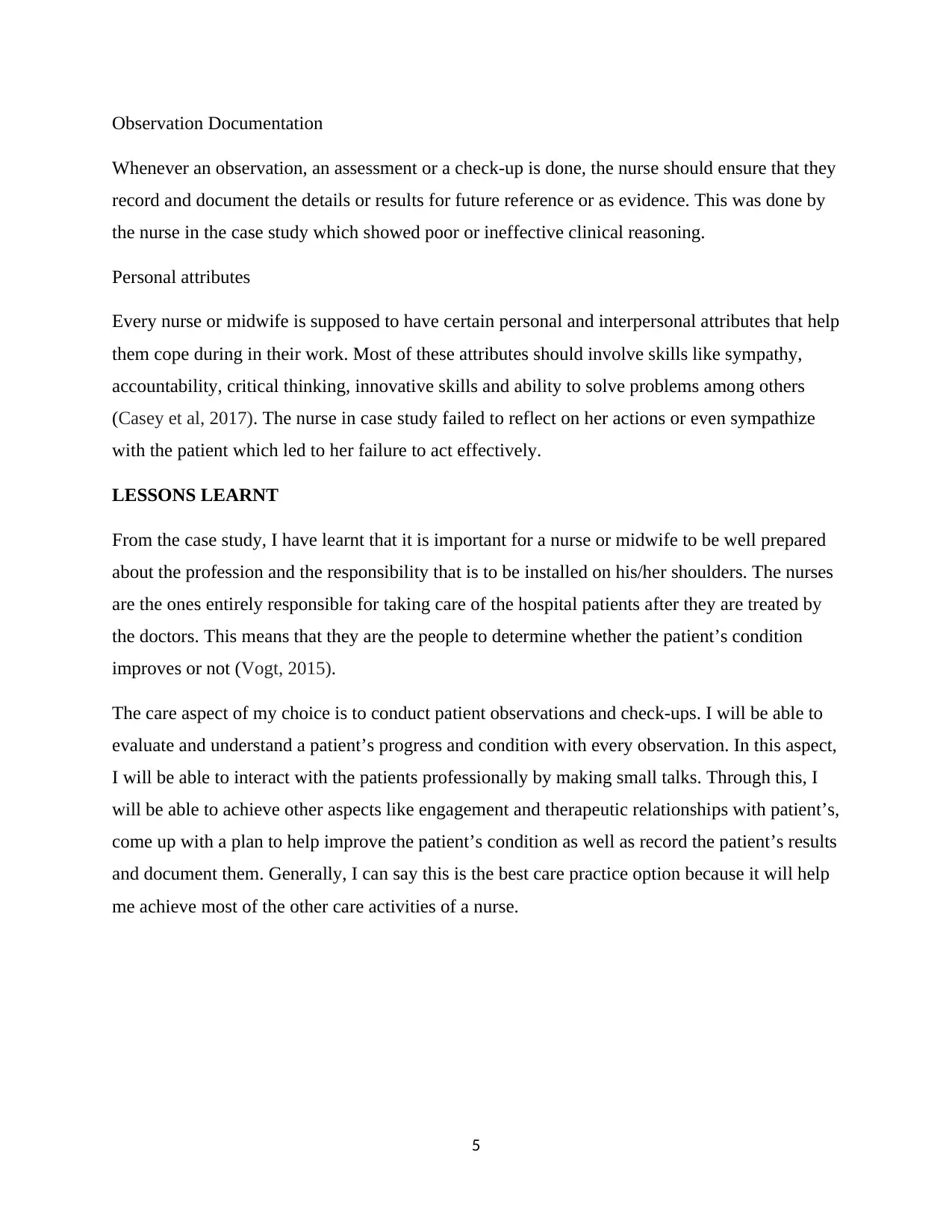
Observation Documentation
Whenever an observation, an assessment or a check-up is done, the nurse should ensure that they
record and document the details or results for future reference or as evidence. This was done by
the nurse in the case study which showed poor or ineffective clinical reasoning.
Personal attributes
Every nurse or midwife is supposed to have certain personal and interpersonal attributes that help
them cope during in their work. Most of these attributes should involve skills like sympathy,
accountability, critical thinking, innovative skills and ability to solve problems among others
(Casey et al, 2017). The nurse in case study failed to reflect on her actions or even sympathize
with the patient which led to her failure to act effectively.
LESSONS LEARNT
From the case study, I have learnt that it is important for a nurse or midwife to be well prepared
about the profession and the responsibility that is to be installed on his/her shoulders. The nurses
are the ones entirely responsible for taking care of the hospital patients after they are treated by
the doctors. This means that they are the people to determine whether the patient’s condition
improves or not (Vogt, 2015).
The care aspect of my choice is to conduct patient observations and check-ups. I will be able to
evaluate and understand a patient’s progress and condition with every observation. In this aspect,
I will be able to interact with the patients professionally by making small talks. Through this, I
will be able to achieve other aspects like engagement and therapeutic relationships with patient’s,
come up with a plan to help improve the patient’s condition as well as record the patient’s results
and document them. Generally, I can say this is the best care practice option because it will help
me achieve most of the other care activities of a nurse.
5
Whenever an observation, an assessment or a check-up is done, the nurse should ensure that they
record and document the details or results for future reference or as evidence. This was done by
the nurse in the case study which showed poor or ineffective clinical reasoning.
Personal attributes
Every nurse or midwife is supposed to have certain personal and interpersonal attributes that help
them cope during in their work. Most of these attributes should involve skills like sympathy,
accountability, critical thinking, innovative skills and ability to solve problems among others
(Casey et al, 2017). The nurse in case study failed to reflect on her actions or even sympathize
with the patient which led to her failure to act effectively.
LESSONS LEARNT
From the case study, I have learnt that it is important for a nurse or midwife to be well prepared
about the profession and the responsibility that is to be installed on his/her shoulders. The nurses
are the ones entirely responsible for taking care of the hospital patients after they are treated by
the doctors. This means that they are the people to determine whether the patient’s condition
improves or not (Vogt, 2015).
The care aspect of my choice is to conduct patient observations and check-ups. I will be able to
evaluate and understand a patient’s progress and condition with every observation. In this aspect,
I will be able to interact with the patients professionally by making small talks. Through this, I
will be able to achieve other aspects like engagement and therapeutic relationships with patient’s,
come up with a plan to help improve the patient’s condition as well as record the patient’s results
and document them. Generally, I can say this is the best care practice option because it will help
me achieve most of the other care activities of a nurse.
5
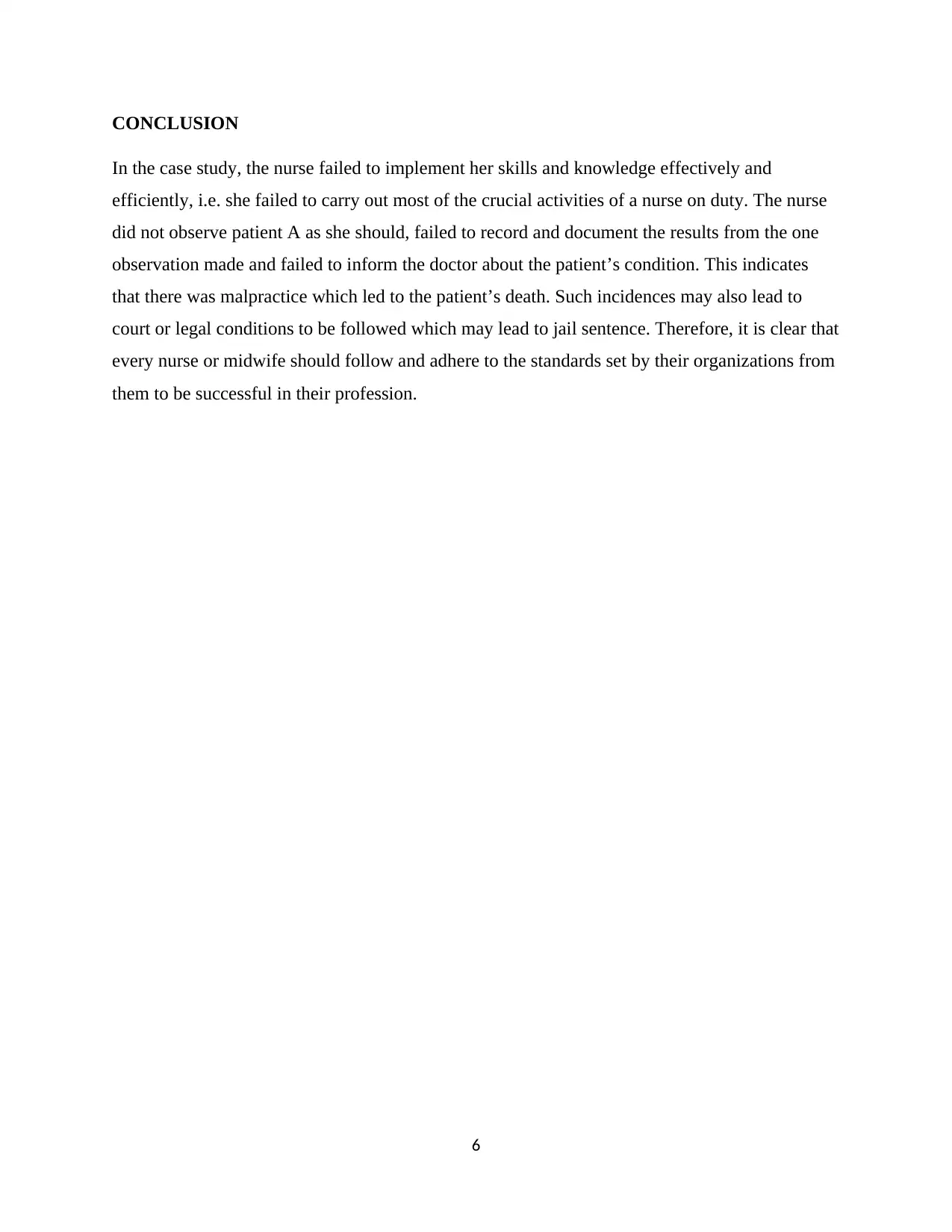
CONCLUSION
In the case study, the nurse failed to implement her skills and knowledge effectively and
efficiently, i.e. she failed to carry out most of the crucial activities of a nurse on duty. The nurse
did not observe patient A as she should, failed to record and document the results from the one
observation made and failed to inform the doctor about the patient’s condition. This indicates
that there was malpractice which led to the patient’s death. Such incidences may also lead to
court or legal conditions to be followed which may lead to jail sentence. Therefore, it is clear that
every nurse or midwife should follow and adhere to the standards set by their organizations from
them to be successful in their profession.
6
In the case study, the nurse failed to implement her skills and knowledge effectively and
efficiently, i.e. she failed to carry out most of the crucial activities of a nurse on duty. The nurse
did not observe patient A as she should, failed to record and document the results from the one
observation made and failed to inform the doctor about the patient’s condition. This indicates
that there was malpractice which led to the patient’s death. Such incidences may also lead to
court or legal conditions to be followed which may lead to jail sentence. Therefore, it is clear that
every nurse or midwife should follow and adhere to the standards set by their organizations from
them to be successful in their profession.
6
⊘ This is a preview!⊘
Do you want full access?
Subscribe today to unlock all pages.

Trusted by 1+ million students worldwide
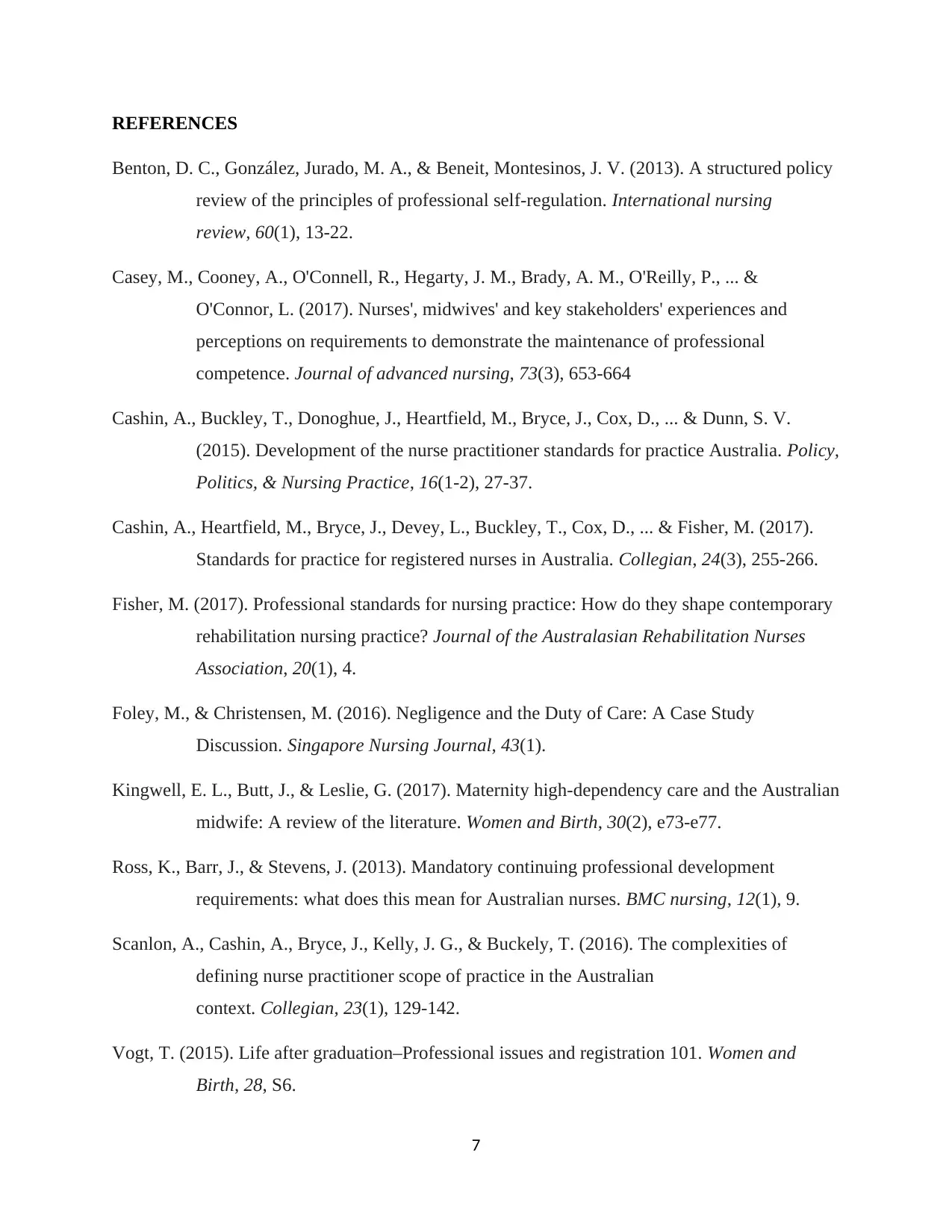
REFERENCES
Benton, D. C., González, Jurado, M. A., & Beneit, Montesinos, J. V. (2013). A structured policy
review of the principles of professional self-regulation. International nursing
review, 60(1), 13-22.
Casey, M., Cooney, A., O'Connell, R., Hegarty, J. M., Brady, A. M., O'Reilly, P., ... &
O'Connor, L. (2017). Nurses', midwives' and key stakeholders' experiences and
perceptions on requirements to demonstrate the maintenance of professional
competence. Journal of advanced nursing, 73(3), 653-664
Cashin, A., Buckley, T., Donoghue, J., Heartfield, M., Bryce, J., Cox, D., ... & Dunn, S. V.
(2015). Development of the nurse practitioner standards for practice Australia. Policy,
Politics, & Nursing Practice, 16(1-2), 27-37.
Cashin, A., Heartfield, M., Bryce, J., Devey, L., Buckley, T., Cox, D., ... & Fisher, M. (2017).
Standards for practice for registered nurses in Australia. Collegian, 24(3), 255-266.
Fisher, M. (2017). Professional standards for nursing practice: How do they shape contemporary
rehabilitation nursing practice? Journal of the Australasian Rehabilitation Nurses
Association, 20(1), 4.
Foley, M., & Christensen, M. (2016). Negligence and the Duty of Care: A Case Study
Discussion. Singapore Nursing Journal, 43(1).
Kingwell, E. L., Butt, J., & Leslie, G. (2017). Maternity high-dependency care and the Australian
midwife: A review of the literature. Women and Birth, 30(2), e73-e77.
Ross, K., Barr, J., & Stevens, J. (2013). Mandatory continuing professional development
requirements: what does this mean for Australian nurses. BMC nursing, 12(1), 9.
Scanlon, A., Cashin, A., Bryce, J., Kelly, J. G., & Buckely, T. (2016). The complexities of
defining nurse practitioner scope of practice in the Australian
context. Collegian, 23(1), 129-142.
Vogt, T. (2015). Life after graduation–Professional issues and registration 101. Women and
Birth, 28, S6.
7
Benton, D. C., González, Jurado, M. A., & Beneit, Montesinos, J. V. (2013). A structured policy
review of the principles of professional self-regulation. International nursing
review, 60(1), 13-22.
Casey, M., Cooney, A., O'Connell, R., Hegarty, J. M., Brady, A. M., O'Reilly, P., ... &
O'Connor, L. (2017). Nurses', midwives' and key stakeholders' experiences and
perceptions on requirements to demonstrate the maintenance of professional
competence. Journal of advanced nursing, 73(3), 653-664
Cashin, A., Buckley, T., Donoghue, J., Heartfield, M., Bryce, J., Cox, D., ... & Dunn, S. V.
(2015). Development of the nurse practitioner standards for practice Australia. Policy,
Politics, & Nursing Practice, 16(1-2), 27-37.
Cashin, A., Heartfield, M., Bryce, J., Devey, L., Buckley, T., Cox, D., ... & Fisher, M. (2017).
Standards for practice for registered nurses in Australia. Collegian, 24(3), 255-266.
Fisher, M. (2017). Professional standards for nursing practice: How do they shape contemporary
rehabilitation nursing practice? Journal of the Australasian Rehabilitation Nurses
Association, 20(1), 4.
Foley, M., & Christensen, M. (2016). Negligence and the Duty of Care: A Case Study
Discussion. Singapore Nursing Journal, 43(1).
Kingwell, E. L., Butt, J., & Leslie, G. (2017). Maternity high-dependency care and the Australian
midwife: A review of the literature. Women and Birth, 30(2), e73-e77.
Ross, K., Barr, J., & Stevens, J. (2013). Mandatory continuing professional development
requirements: what does this mean for Australian nurses. BMC nursing, 12(1), 9.
Scanlon, A., Cashin, A., Bryce, J., Kelly, J. G., & Buckely, T. (2016). The complexities of
defining nurse practitioner scope of practice in the Australian
context. Collegian, 23(1), 129-142.
Vogt, T. (2015). Life after graduation–Professional issues and registration 101. Women and
Birth, 28, S6.
7
Paraphrase This Document
Need a fresh take? Get an instant paraphrase of this document with our AI Paraphraser

8
1 out of 8
Related Documents
Your All-in-One AI-Powered Toolkit for Academic Success.
+13062052269
info@desklib.com
Available 24*7 on WhatsApp / Email
![[object Object]](/_next/static/media/star-bottom.7253800d.svg)
Unlock your academic potential
Copyright © 2020–2025 A2Z Services. All Rights Reserved. Developed and managed by ZUCOL.




